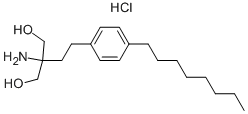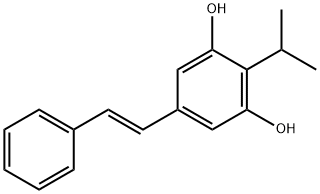Fingolimod HCl , ≥98% , 162359-56-0
Synonym(s):
2-Amino-2-[2-(4-octyl-phenyl)-ethyl]-propane-1,3-diol hydrochloride;Fingolimod hydrochloride;FTY720
CAS NO.:162359-56-0
Empirical Formula: C19H34ClNO2
Molecular Weight: 343.93
MDL number: MFCD00939512
EINECS: 680-631-1
| Pack Size | Price | Stock | Quantity |
| 100MG | RMB208.00 | In Stock |
|
| 250MG | RMB332.80 | In Stock |
|
| 1g | RMB1053.60 | In Stock |
|
| 5g | RMB3740.00 | In Stock |
|
| others | Enquire |
PRODUCT Properties
| Melting point: | 102-107°C |
| storage temp. | -20°C |
| solubility | water: soluble10mg/mL, clear |
| form | powder |
| color | white to beige |
| biological source | synthetic |
| Water Solubility | water: 10mg/mL, clear |
| Merck | 14,4083 |
| Stability: | Stable for 1 year from date of purchase as supplied. Solutions in DMSO or ethanol may be stored at -20° for up to 3 months. |
| InChI | InChI=1S/C19H33NO2.ClH/c1-2-3-4-5-6-7-8-17-9-11-18(12-10-17)13-14-19(20,15-21)16-22;/h9-12,21-22H,2-8,13-16,20H2,1H3;1H |
| InChIKey | SWZTYAVBMYWFGS-UHFFFAOYSA-N |
| SMILES | C1(C=CC(CCCCCCCC)=CC=1)CCC(N)(CO)CO.Cl |
| CAS DataBase Reference | 162359-56-0(CAS DataBase Reference) |
Description and Uses
Approved by the U.S. FDA in September 2010, fingolimod (also referred to as FTY720) is the first approved oral therapy for the relapsing-remitting form ofmultiple sclerosis (RRMS). Because of fingolimod’s structural resemblance to sphingosine, a metabolite of sphingolipids that constitutes the cell membrane of all eukaryotic cells, it was hypothesized that fingolimod may be affecting sphingolipid metabolism in cells. A series of elegant in vitro and in vivo studies confirmed that fingolimod is converted to (S)-fingolimod phosphate primarily by sphingosine kinase- 2 and that (S)-fingolimod phosphate mediates multiple biological processes by binding to novel GPCR’s referred to as sphingosine-1-phosphate (S1P) receptors. S1P receptors are divided into five subtypes, S1P1–5, which have varying tissue and cellular distribution. S1P1–3 receptors are ubiquitously expressed in the immune, cardiovascular, and central nervous systems, S1P4 is restricted to the hematopoietic system, and S1P5 is mostly localized in the white matter of CNS. S1P1–3 receptors play important roles in endothelial barrier function, maintaining vascular tone, regulating heart rate and allowing for lymphocyte egress fromsecondary lymphoid organs. The functional role of S1P4 is unknown,while the S1P5 receptor is thought to be involved in natural killer cell trafficking and oligodendrocyte function.
A cell-permeable aminopropanediol immunosuppressive agent that displays lymphocyte sequestration properties.
Safety
| Symbol(GHS) |  GHS08 |
| Signal word | Warning |
| Hazard statements | H373 |
| Precautionary statements | P260-P314-P501 |
| Hazard Codes | Xi |
| Risk Statements | 36/37/38-52/53 |
| Safety Statements | 26-61 |
| WGK Germany | 3 |
| RTECS | TY3130000 |
| HS Code | 29221990 |
| Toxicity | LD50 orally in rats: 300-600 mg/kg (Troncoso) |






